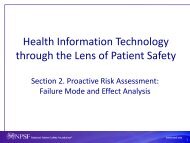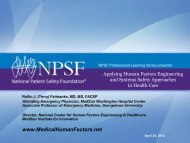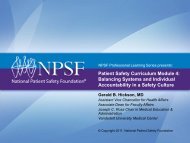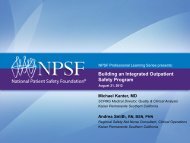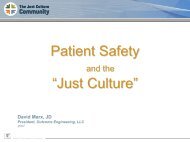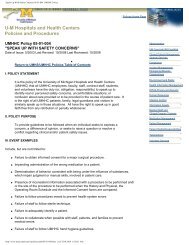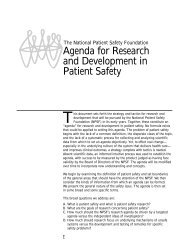Health Information Technology through the Lens of Patient Safety
Health Information Technology through the Lens of Patient Safety
Health Information Technology through the Lens of Patient Safety
Create successful ePaper yourself
Turn your PDF publications into a flip-book with our unique Google optimized e-Paper software.
<strong>Health</strong> <strong>Information</strong> <strong>Technology</strong><strong>through</strong> <strong>the</strong> <strong>Lens</strong> <strong>of</strong> <strong>Patient</strong> <strong>Safety</strong>Section 4. HIT Adoption andSystem Design1
Keys to Successful HITImplementation• Involving key stakeholders• Using human factors engineering anddeliberate system design2
Involving Key Stakeholders1. Identifying potential barriers2. Defining success3. Developing training3
1. Identifying Barriers• Develop an effective plan with end-usersupport• Solicit feedback from end users• Use evaluation process to identify potentialbarriers4
2. Defining Success• Involve key stakeholders in determiningvision and guiding principles• Ensure stakeholders’ role in establishinggoals5
3. Developing Training• Demonstrate <strong>the</strong> value to <strong>the</strong> end user• Show how HIT can improve patient safety andprotect <strong>the</strong> end user from causing harm• Use effective training to increase adoptionand safe use <strong>of</strong> newprocesses6
Using Human Factors Engineeringand Deliberate System Design• Make it easier to do <strong>the</strong> right thing• Make it harder to do <strong>the</strong> wrong thing• Reduce failure modes• Support safe, efficient, effective care• Support caregivers in decision making• Automate “routine” tasks7
Steps Related to System Design1. Determining <strong>the</strong> impact onworkflows2. Paying attention to key factors forcare delivery3. Analyzing <strong>the</strong> physical environmentand population served4. Establishing maintenance processes8
1. Determining Impact on Workflows• Ensure involvement <strong>of</strong> key stakeholders• Outline all steps in work processes• Identify strengths and weaknesses <strong>of</strong>current processes• Incorporate favorable processes intosystem design• Develop vendor specifications9
2. Paying Attention to Key Factorsfor Care Delivery• Integration• Deliberate design in workstations• Ease <strong>of</strong> use• Variations in practice• Cognitive impact• Location <strong>of</strong> input and retrieval devices10
Integration• Review policies and procedures for facilitylevelnormalization and standardization• Drive clinicians to computer for reliableinformation• Enable end user to access frequently usedinformation quickly11
Deliberate Design in Workstations• Use a mix <strong>of</strong> mobile and stationary workstations• Base number on maximum users at busiest time• Establish cleaning procedures, maintenanceprocesses, and equipment storage processes• Consider battery life and need for secure storagefor mobile devices• Consult guidelines concerning devices left inhallways for extended periods12
Ease <strong>of</strong> Use• Sync passwords• Base monitor size on optimal resolution andminimal scrolling• Locate point-<strong>of</strong>-useequipment close topatient locations13
Variations in Practice• Keep track <strong>of</strong> process changes, even if minimal• Implement major changes prior to systemimplementation• Avoid inserting technology on faulty processes14
Cognitive Impact• Consider possible loss <strong>of</strong> colleague supportduring charting• Avoid removing clinician’s need to understandlogic for reaching a conclusion• Develop an alert philosophy15
Location <strong>of</strong> Input and RetrievalDevices• Ensure a sufficient number <strong>of</strong> devices• Consider <strong>the</strong> need for eye contact• Consider <strong>the</strong> need for data display at <strong>the</strong>bedside16
3. Analyzing <strong>the</strong> Physical Environ-ment and Population Served• Conduct an environmental analysis <strong>of</strong> eachdepartment• Determine how <strong>the</strong> population is currentlyserved and how layout affects clinical processes• Evaluate roles and responsibilities <strong>of</strong> staff• Assess <strong>the</strong> population served and risks• Consider risk <strong>of</strong> harm from wires andequipment17
4. Establishing MaintenanceProcesses• Creating a preventative maintenance andreplacement program• Establishing a process for system changes,upgrades, and redesign18
Creating a Preventive Maintenanceand Replacement Program• Establish and communicate processes forplanned maintenance and replacements• Inventory equipment and assess devices• Ensure intradepartmental coordination• Consider timing <strong>of</strong> event to minimizedisturbance and risk <strong>of</strong> safety hazards• Plan longer scheduled downtimes during <strong>of</strong>fhours19
Establishing a Process for SystemChanges, Upgrades, and Redesign• Select metrics and define success criteria• Ensure that metrics are reflective <strong>of</strong> systemgoals• Choose different metricsover time20
References• Chaudhry B, Wang J, Wu S, et al. 2006. Systematic review:impact <strong>of</strong> health information technology on quality, efficiency,and costs <strong>of</strong> medical care. Ann Intern Med. 144:742–752.• Elder KT, Wiltshire JC, Rooks RN, Belue R, Gary LC. 2010. <strong>Health</strong>information technology and physician career satisfaction.Perspect <strong>Health</strong> Inf Manag. 7 pii: 1d.• Federal Aviation Administration (FAA). 2000. Human factorsengineering and safety principles and practices. In: FAA System<strong>Safety</strong> Handbook. Washington DC: Federal AviationAdministration.http://www.faa.gov/library/manuals/aviation/risk_management/ss_handbook/. Accessed Apr 11, 2012.21
References, cont.• Kohn LT, Corrigan JM, Donaldson MS, eds. 2000. To Err IsHuman: Building a Safer <strong>Health</strong> System. Institute <strong>of</strong> Medicine(IOM), Committee on Quality <strong>of</strong> <strong>Health</strong> Care in America.Washington, DC: National Academy Press.• Krause T, Dunn S. 2006. How are leadership and culturerelated to patient safety? Behavioral Science <strong>Technology</strong>, Inc.http://www.worldcongress.com/events/HR09000/pdf/thoughtleadership/bst/WhitePaper%20-%20How%20Are%20Leadership%20and%20Culture%20are%20Related%20to%20<strong>Patient</strong>%20<strong>Safety</strong>%20Mar%202007.pdf.Accessed Sep 15, 2011.22
References, cont.• Lucian Leape Institute (LLI). 2011. <strong>Health</strong> <strong>Information</strong><strong>Technology</strong> and <strong>Patient</strong> <strong>Safety</strong>: A Dynamic Discussion.Proceedings <strong>of</strong> <strong>the</strong> Lucian Leape Institute at <strong>the</strong> National<strong>Patient</strong> <strong>Safety</strong> Foundation Third Annual Forum and Gala,Boston, MA, 2010. http://www.npsf.org/wp-content/uploads/2011/10/LLI_Forum-Gala2010_Proceedings_web.pdf. Accessed Apr 10, 2012.• McGowan JJ, Cusack CM, Poon EG. 2008. Formativeevaluation: a critical component in EHR implementation. J AmMed Inform Assoc. 15(3):297–301. Epub Feb 28, 2008.23
References, cont.• Walker J, Carayon P. 2009. From tasks to processes: <strong>the</strong> casefor changing health information technology to improve healthcare. <strong>Health</strong> Aff (Millwood). 28(2):467–477.http://content.healthaffairs.org/content/28/2/467.full.html.Accessed Jul 11, 2011.24
Copyright © 2013 by <strong>the</strong> National <strong>Patient</strong> <strong>Safety</strong> Foundation, Boston, Massachusetts.Purchasers <strong>of</strong> this online publication may download, save, and print individual copies without permission from NPSF.This publication may not be reproduced for mass distribution without permission in writing from <strong>the</strong> publisher:National <strong>Patient</strong> <strong>Safety</strong> Foundation268 Summer Street, Sixth FloorBoston, MA 02210info@npsf.org25




